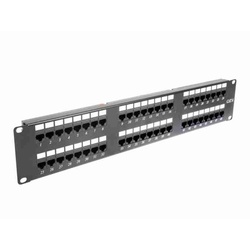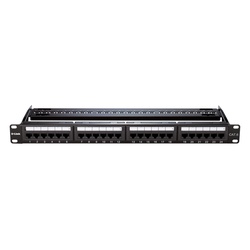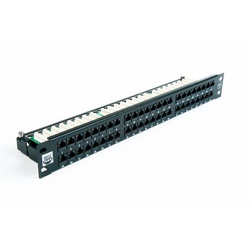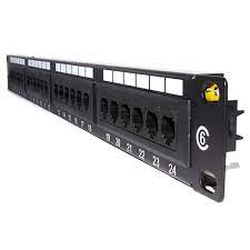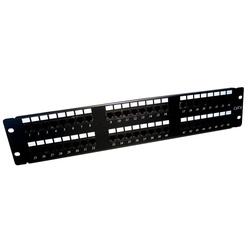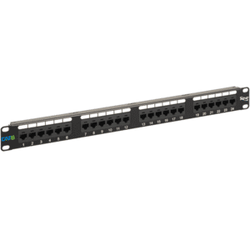
APKR Patch Panel 24 Port
The APKR Patch Panel 24 Port is a networking component used in structured cabling systems to manage and organize network connections. It provides a centralized location for terminating and interconnecting network cables, allowing for easy administration, troubleshooting, and maintenance of network infrastructure.
- Port Capacity: The patch panel has 24 ports, which means it can accommodate up to 24 network connections. Each port typically corresponds to an individual network cable or an incoming/outgoing connection.
- Rack-Mountable Design: The patch panel is designed to be mounted on a standard 19-inch equipment rack, ensuring compatibility with standard networking setups. It typically occupies 1U (1 rack unit) of vertical space.
- Port Labeling: Each port on the patch panel is usually numbered and labeled, allowing for easy identification and organization of network connections. The labeling can be either on the front or rear of the panel, depending on the specific model.
- Connectivity: The patch panel provides a passive connection point for network cables. It does not contain any active components such as switches or routers. Instead, it serves as a termination point for cables coming from various network devices, such as computers, servers, switches, or routers.
| SKU | 1281 |
|---|
Reviews
This product does not have any reviews yet.
Add your reviewDescription
APKR Patch Panel 24 Port
The APKR Patch Panel is a networking component used in structured cabling systems to manage and organize network connections. A patch panel acts as a central point for terminating and interconnecting network cables, providing a neat and structured solution for network connectivity.
Key Features
-
Port Quantity: The APKR Patch Panel has 24 ports, allowing you to terminate up to 24 network cables.
-
Port Configuration: Each port on the patch panel is designed to accommodate an RJ45 connector, which is commonly used for Ethernet connections. These ports provide the physical interface for connecting network devices such as computers, switches, routers, and servers.
-
Design: The patch panel is usually designed as a rack-mountable unit, allowing it to be easily installed in standard network racks or cabinets. It typically occupies 1U (1 rack unit) of space, which is equivalent to 1.75 inches in height.
-
Labeling: The patch panel is usually equipped with clear labeling on both the front and back sides. This labeling helps in identifying and organizing the connections, making it easier to troubleshoot or reconfigure the network.
-
Cable Management: The patch panel often includes cable management features such as cable ties, clips, or routing channels. These features help to organize and secure the incoming and outgoing cables, reducing cable clutter and improving airflow within the network rack.
-
Termination: Each port on the patch panel is connected to a punch-down or keystone-style termination point. The punch-down termination allows for solid-core cables to be terminated using a punch-down tool, while the keystone-style termination accepts modular connectors for stranded or pre-terminated cables.
-
Backward Compatibility: The APKR Patch Panel is typically designed to support various network speeds, including Fast Ethernet (10/100 Mbps), Gigabit Ethernet (10/100/1000 Mbps), and potentially higher speeds like 10 Gigabit Ethernet (10 Gbps) or beyond. It ensures backward compatibility, allowing you to connect devices with different network capabilities.
-
Grounding: The patch panel may include grounding capabilities to provide electrical grounding and minimize the risk of electrical surges or interference.

